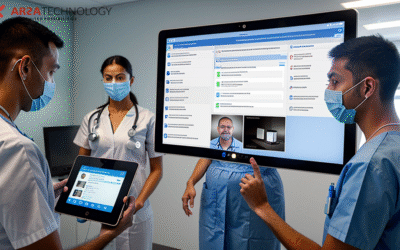Introduction: Overcoming Manual Inventory and Traffic Analysis in the Retail Industry
The retail landscape is in constant flux, driven by evolving consumer expectations and the relentless pursuit of operational efficiency. For many businesses, the foundational challenge remains the same: how to accurately understand customer behavior and manage inventory without relying on labor-intensive, often inaccurate manual processes. Manual inventory counts, subjective traffic estimations, and retrospective analysis of sales data leave significant gaps, leading to missed opportunities, inefficient resource allocation, and ultimately, reduced profitability. In an era where data is king, relying on outdated methods for such critical insights is no longer sustainable.
ARSA Technology recognizes this pressing need for transformation. Our Face Recognition API offers a powerful, scalable solution designed to usher retail operations into a new era of intelligence. This article serves as a strategic guide for developers, solutions architects, CTOs, and product managers looking to migrate from cumbersome manual systems to an automated, AI-driven approach, leveraging the power of facial recognition to revolutionize inventory management, traffic analysis, and overall customer experience.
The Hidden Costs of Manual Retail Operations
Manual processes, while seemingly straightforward, carry substantial hidden costs and inefficiencies. Consider the following:
- Inaccurate Inventory: Manual counts are prone to human error, leading to discrepancies between reported and actual stock levels. This results in overstocking, understocking, lost sales, and increased carrying costs.
- Subjective Traffic Analysis: Estimating foot traffic or relying on simple door counters provides only a superficial understanding of customer flow. It fails to capture demographic data, dwell times, pathing, or repeat visits, which are crucial for optimizing store layouts and staffing.
- Inefficient Staffing: Without precise data on peak hours and customer density, scheduling staff becomes a guessing game. This can lead to overstaffing during slow periods and understaffing during busy times, impacting customer service and labor costs.
- Delayed Insights: Manual data collection and analysis are time-consuming, meaning insights are often retrospective and not actionable in real-time. By the time trends are identified, opportunities may have already passed.
- Limited Personalization: A lack of granular customer behavior data prevents retailers from offering truly personalized experiences, a key differentiator in today’s competitive market.
These challenges collectively hinder a retailer’s ability to adapt quickly, optimize resources, and deliver the seamless, personalized experiences that modern consumers demand. The migration to an automated system is not just an upgrade; it’s a strategic imperative for survival and growth.
The Strategic Shift to AI-Powered Retail Insights
The integration of AI, particularly through technologies like face recognition, marks a pivotal shift for the retail sector. It moves beyond traditional security applications to become a core component of business intelligence. By automating the collection and analysis of customer data, retailers can gain unprecedented visibility into their operations, transforming raw data into actionable insights.
Imagine a system that can:
* Accurately count unique visitors and track their movements throughout the store.
* Identify peak shopping hours and areas, allowing for dynamic staffing adjustments.
* Understand demographic trends to tailor product placements and marketing campaigns.
* Recognize returning customers to offer personalized greetings or recommendations.
* Detect suspicious activities to enhance loss prevention efforts.
This level of insight is precisely what ARSA Technology’s Face Recognition API enables, providing a robust foundation for data-driven decision-making across the entire retail ecosystem.
ARSA Technology’s Face Recognition API: A Retail Game-Changer
ARSA Technology’s Face Recognition API is engineered to deliver high-performance, accurate facial recognition capabilities, making it ideal for the demanding retail environment. It provides the tools necessary to move beyond guesswork, offering precise data that empowers retailers to make informed strategic and operational decisions.
The API’s core capabilities include:
- Accurate Face Detection and Identification: Precisely locate and identify individuals within a given image or video stream. This is fundamental for tracking unique visitors and understanding customer flow.
- Demographic Analysis: Gain insights into customer demographics (e.g., age range, gender) to better understand your audience and tailor offerings.
- Visitor Tracking: Monitor customer paths, dwell times in specific zones, and repeat visits, providing invaluable data for store layout optimization and marketing effectiveness.
- Enhanced Security and Loss Prevention: By identifying known individuals or detecting unusual patterns, the API can bolster security measures and aid in loss prevention. For more advanced fraud prevention, consider supplementing with solutions for preventing fraud with liveness detection.
To see the API in action and explore its capabilities interactively, try the Face Recognition API on RapidAPI. This playground allows developers to quickly understand the API’s functionality and potential without needing to write any code.
Key Benefits of Migrating to ARSA’s Face Recognition API
Migrating from manual processes to ARSA’s Face Recognition API offers a multitude of tangible benefits for retail businesses:
- Enhanced Customer Experience and Personalization: By understanding customer preferences and behaviors, retailers can offer tailored recommendations, faster service, and more relevant promotions, fostering loyalty and increasing sales. The API can facilitate the creation of personalized shopping journeys, from greeting known customers by name to suggesting products based on past interactions.
- Optimized Store Operations and Resource Allocation: Real-time data on customer traffic, hot zones, and queue lengths allows for dynamic staffing adjustments, ensuring optimal service levels during peak times and reducing labor costs during slower periods. Inventory management becomes more precise, as insights into popular areas can inform product placement and restocking strategies.
- Improved Loss Prevention and Security: The API can be integrated with existing surveillance systems to identify individuals of interest, detect suspicious behavior, and provide alerts to security personnel. This proactive approach significantly reduces shrinkage and enhances overall store safety. This complements existing secure identity verification solutions for staff and high-value transactions.
- Data-Driven Decision Making: Move beyond anecdotal evidence and subjective observations. With accurate, real-time data on customer behavior, retailers can make informed decisions about store layouts, product assortments, marketing campaigns, and promotional strategies, leading to higher ROI.
- Scalability and Future-Proofing: ARSA Technology’s API is built for enterprise-grade performance and scalability, capable of handling the demands of single stores to large retail chains. It provides a flexible foundation that can evolve with your business needs, integrating with other systems to unlock even greater value.
The Migration Journey: A Strategic Overview
A successful migration to ARSA’s Face Recognition API requires a strategic, phased approach, focusing on business outcomes rather than just technical implementation.
1. Assessment and Planning:
* Define Objectives: Clearly articulate what you aim to achieve (e.g., reduce manual inventory errors by X%, increase customer engagement by Y%).
* Identify Integration Points: Determine where face recognition data will be most impactful within your existing retail ecosystem (e.g., POS systems, CRM, analytics dashboards, security cameras).
* Data Strategy: Plan how data will be collected, processed, and utilized, ensuring compliance with privacy regulations from the outset.
* Team Alignment: Engage key stakeholders from IT, operations, marketing, and legal to ensure buy-in and a smooth transition.
2. Pilot Program and Proof of Concept:
* Start with a limited deployment in a single store or a specific department to validate the API’s effectiveness in your environment.
* Gather initial data and feedback to refine your strategy and identify any unforeseen challenges.
* The RapidAPI playground is an excellent resource for quick prototyping and understanding the API’s capabilities before full integration.
3. Phased Integration and Deployment:
* Based on pilot results, roll out the API across more locations or integrate it with additional systems.
* Focus on delivering incremental value at each stage, demonstrating ROI and building confidence.
* Ensure robust monitoring and alerting systems are in place to track performance and identify issues.
4. Training and Adoption:
* Train your operational staff on how to interpret and act upon the new insights provided by the API.
* Emphasize the benefits to their daily work, fostering adoption and maximizing the value of the new system.
5. Continuous Optimization:
* The retail environment is dynamic. Continuously analyze the data generated by the Face Recognition API to identify new trends, refine strategies, and uncover further opportunities for optimization.
* ARSA Technology is committed to continuous improvement, ensuring the API remains at the forefront of facial recognition technology.
Ensuring Data Privacy and Compliance
In any discussion of facial recognition technology, data privacy and ethical considerations are paramount. ARSA Technology is committed to providing solutions that enable businesses to operate responsibly and in compliance with global data protection regulations such as GDPR and CCPA.
When implementing the Face Recognition API, retailers must:
- Prioritize Transparency: Clearly inform customers about the use of facial recognition technology within your stores.
- Obtain Consent (where required): Implement mechanisms for obtaining explicit consent where legally mandated.
- Implement Robust Security Measures: Protect collected data with strong encryption and access controls.
- Adhere to Data Minimization Principles: Collect only the data necessary for your defined business objectives.
- Establish Data Retention Policies: Define clear policies for how long data will be stored and when it will be securely deleted.
ARSA Technology provides the tools; responsible implementation is a shared responsibility. By integrating these best practices, retailers can leverage the power of facial recognition while maintaining customer trust and regulatory compliance.
Conclusion: Your Next Step Towards a Solution
The retail industry stands at a crossroads. The choice is clear: continue to grapple with the limitations and costs of manual inventory and traffic analysis, or embrace the transformative power of AI-driven insights. Migrating to ARSA Technology’s Face Recognition API is more than a technical upgrade; it’s a strategic investment in the future of your retail business. It promises enhanced operational efficiency, deeper customer understanding, superior loss prevention, and a competitive edge in a rapidly evolving market.
By making this strategic shift, you empower your organization with the data and intelligence needed to optimize every facet of your retail operations, from personalized customer experiences to precise inventory management. The journey towards an intelligent, data-driven retail future begins now.
Ready to Solve Your Challenges with AI?
Discover how ARSA Technology can help you overcome your toughest business challenges. Get in touch with our team for a personalized demo and a free API trial.







